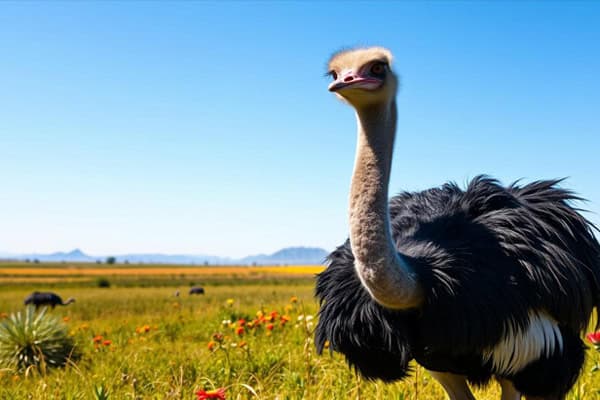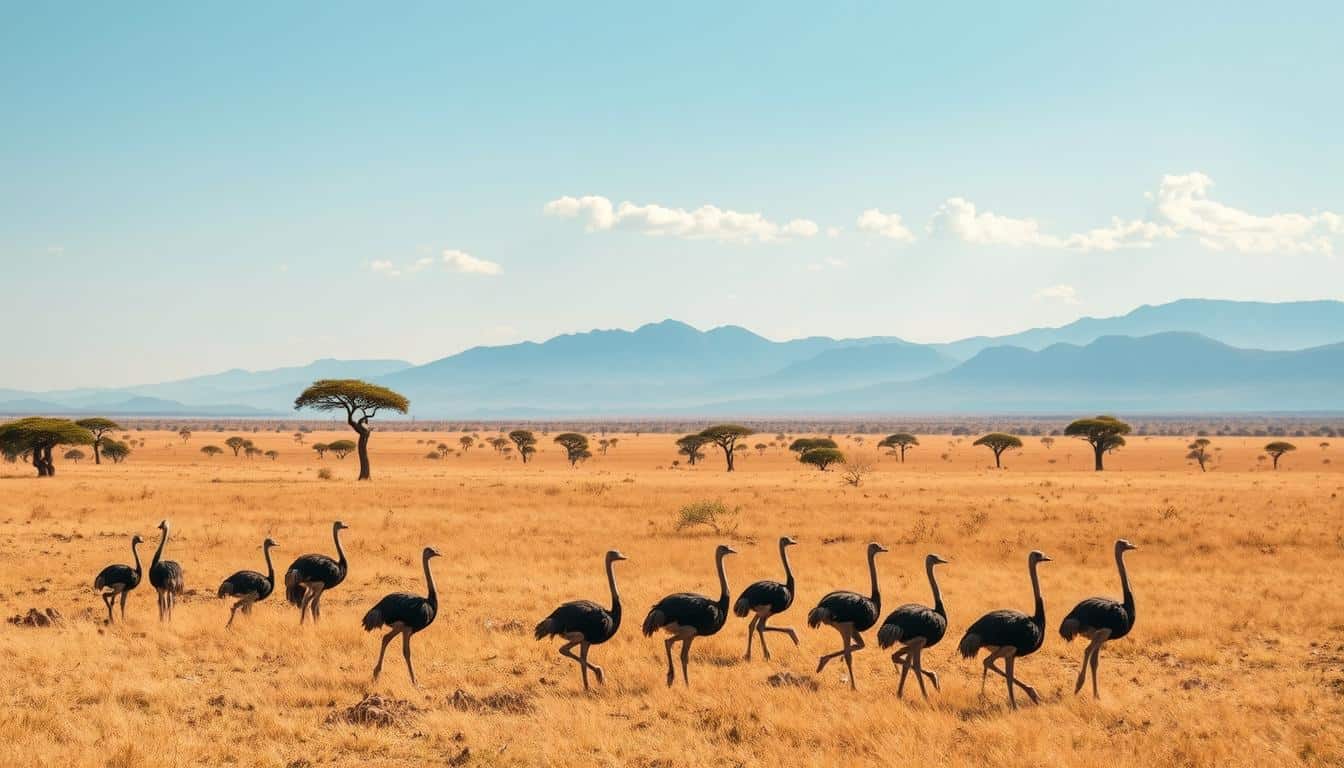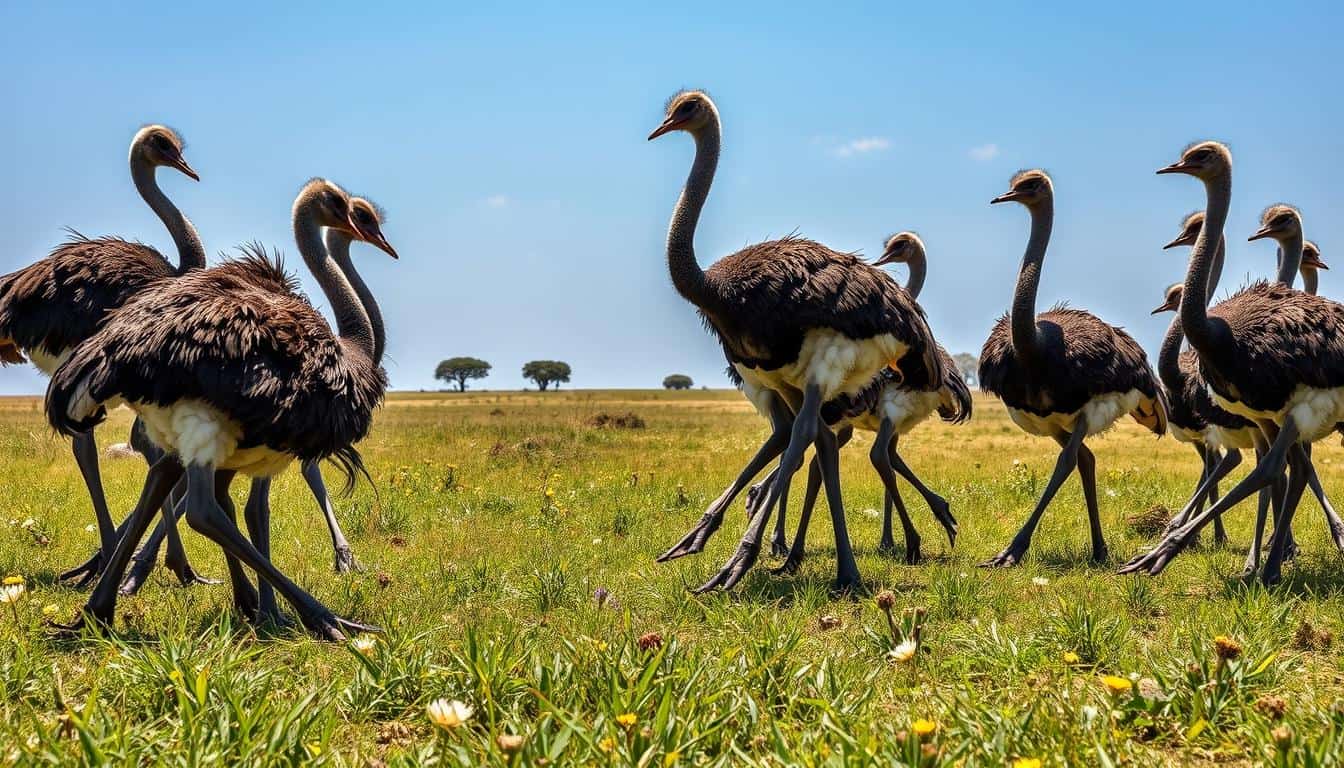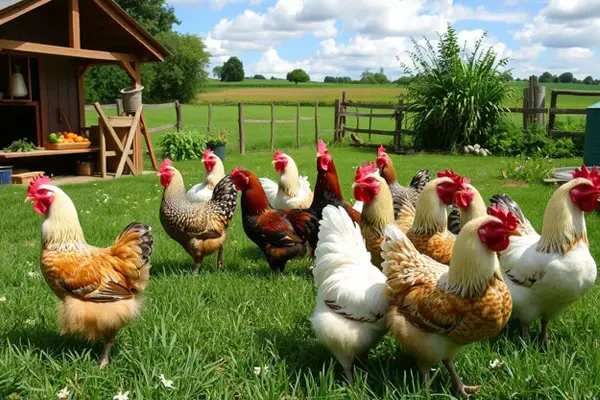The Fascinating World of the Common Ostrich (Struthio camelus)
Did you know the Common Ostrich can grow up to 2.7 meters tall? This makes it the tallest bird alive. They can also run up to 70 kilometres per hour. This makes the common ostrich, or *Struthio camelus*, a bird that amazes many.
We will look at what makes ostriches special. We’ll see where they live, how they act, and their role in the economy. Let’s dive into the world of ostriches and learn why they are so unique.
In this article, we will explore the amazing traits of these birds, including the Somali ostrich, and how ostriches live in various environments. We’ll see where they live, how they socialize, and their importance in the world. Join us to learn more about the common ostrich’s special place in nature and our economy.
Introduction to the Common Ostrich
The common ostrich is a flightless bird that stands out. It is the tallest living bird, with males reaching 6.9 to 9 feet tall. Their powerful legs let them run up to 43 miles per hour.
This speed helps them escape predators. It’s key to their survival.

Overview of Ostriches and Their Characteristics
The common ostrich is known as Struthio camelus. It has unique features that make it different from other birds. Adult males have black feathers with white accents.
Females and young birds have brownish-grey feathers. This helps them blend in with their surroundings, avoiding danger and cannot run away. Four subspecies in Africa show how they adapt to different places.
Importance of the Common Ostrich
Ostrich farming is a big business worldwide. People want their meat, feathers, and leather. These birds are good for local economies.
They offer healthy lean meat. Ostriches also help keep their ecosystems balanced. They connect grazers and predators, keeping nature in check.
Physical Characteristics of the Common Ostrich
The common ostrich has amazing physical traits that make it stand out. It is the biggest living bird, growing up to 2.7 meters tall. Adults can weigh over 150 kg, which is about 330 pounds.
Size and Weight of Adult Ostriches
Adult ostriches are huge and heavy. Males are taller than females, showing off their strong bodies. Their size helps them live in many places, making them top animals.
They can run fast, up to 72.5 km/h or 45 mph, which helps them escape predators like the cheetah. Their strong legs help them run away from danger.
Distinctive Features: Plumage and Legs
The ostrich’s feathers are also special. Males have black-and-white feathers for showing off and hiding. Females have brown feathers that help them blend in.
They have strong legs and sharp claws on their feet. These help them run fast and protect themselves from predators. The ostrich is an amazing bird, showing how nature can create incredible creatures.
Habitat and Distribution
The Common Ostrich thrives in various habitats across Africa. They live in savannas and open woodlands. Their sharp eyes help them spot predators from far away.
Natural Habitat: Savannas and Open Woodlands
In savannas, open woodlands, and dry lands, Common Ostriches adapt well. They have lots of space to move around. This helps them find food and live in groups.
These groups can have five to fifty birds. It’s a way for them to stay safe together.
Global Distribution Across Africa
The Common Ostrich is found in Southern, East, and North Africa. They can live in different climates and places. This shows how well they adapt.
But, the Arabian Ostrich, which is now classified as least concern, almost disappeared in the 20th century. Luckily, the Common Ostrich is still around. In North Africa, they have special ways to survive in dry places.

| Region | Habitat Type for the North African Ostrich is crucial for its survival. | Key Adaptations |
|---|---|---|
| Southern Africa | Savannas | Keen eyesight for predator detection |
| East Africa | Open Woodlands | Social structure in nomadic groups |
| North Africa | Arid Regions | Adaptation for surviving in dryness |
Behaviour and Social Structure of the Common Ostrich
The common ostrich’s social behaviour and structure are quite interesting. They live in groups, sometimes as small as a few birds or as big as 100. A clear hierarchy forms in these groups, mainly due to male competition.
Flock Behavior and Group Dynamics
Ostrich flocks usually have 10 to 12 birds. A dominant male leads the group, showing off through courtship and aggression. He mates with several females, creating a harem of 3 to 5 partners.
This setup helps them reproduce better. It also helps to watch out for predators and raise young people together.
Reproductive Strategies
Ostriches have unique ways of reproducing, often involving a dominant female. Females lay their eggs in a shared nest during breeding season. This nest can hold 2 to 11 eggs, weighing about 3 pounds and 6 inches long.
Female ostriches take turns keeping the eggs warm. The dominant male also guards the nest. This shows how they work together as a family.

| Aspect | Details about their nesting habits reveal that hens often bury their heads in the sand while incubating their eggs. |
|---|---|
| Group Size | Typically 10 to 100 birds |
| Dominant Male Role | Establishes hierarchy and mates with multiple females |
| Communal Nest | Eggs laid by multiple females in one nest |
| Egg Size | Approximately 6 inches long, weighing about 3 pounds |
| Incubation Period | 42 to 46 days |
| Egg Laying | 2 to 11 eggs per nesting |
The Economic Significance of the Common Ostrich
Looking at the common ostrich’s economic value, we can see its importance in ostrich farming. It’s a key player in the agricultural world. Its products help the economy a lot, especially in Africa.
Ostrich Farming and Commercial Applications
Ostrich farming is a green way to make money. These birds need less land than other animals. They also produce less greenhouse gases.
This makes farming them good for the planet. It also creates jobs in local communities. Ostriches can live in dry places, making them perfect for tough environments.
Ostrich Products: Meat, Feathers, and Eggs
Ostrich products are many and valuable. Their meat is lean but packed with protein and iron. It’s ready to eat in about a year, which is good for farmers.
Their eggs are big, up to 2 kg. They can replace many chicken eggs. This helps with the food supply.
Ostrich feathers are big in fashion. They’re also used in cleaning and decorations. This shows how versatile and valuable ostrich products are.
| Ostrich Product | Benefit | Commercial Application |
|---|---|---|
| Meat | Low fat, high protein | Food industry |
| Feathers | Fashionable and versatile | Fashion and decoration |
| Eggs | High nutritional value | Food and handicrafts |
Conclusion
The common ostrich is a fascinating bird. It is the largest living flightless bird. It can grow up to 9.2 feet tall and weigh over 344 pounds.
This bird is not just big. It is also very important for our planet. It plays a big role in our ecosystems, culture, and economy.
The common ostrich has helped us learn about bird conservation. Its survival depends on protecting its home, where ostrich populations can thrive. Ostrich farming helps keep this bird alive, giving us meat, feathers, ostrich eggs, and even chicks for breeding.
Genomic studies have also helped us understand its history. This history is deeply connected to Africa and humans.
By caring for the common ostrich, we connect with nature. Our conservation work protects this amazing bird for the future. It also shows the beauty of life in our world.
We can all help the common ostrich thrive. Let’s work together to keep it alive and fascinating for everyone.
Read More🐦Related Articles:
| Brahma Chicken Care Tips & Facts for Enthusiasts |
| What Do Owls Eat |
| Ducks in Hawaii |
| Hummingbirds in Maryland |
| Discover the Stunning Red-Breasted Goose |
Frequently Asked Questions
Q1. What is the colour of the common ostrich?
Adult male common ostriches have black feathers with white wings and tails, while females are generally brown and gray.
Q2. What is the common ancestor of the bald eagle and ostrich?
The common ancestor would be a prehistoric bird, but exact details are complex due to the vast evolutionary history. Both belong to different lineages, with eagles being part of the Accipitridae family and ostriches belonging to the Palaeognathae group.
Q3. What color is the common ostrich?
As mentioned, males are mostly black with white accents, and females are brownish.
Q4. How does common ostrich movement description?
Common ostriches are known for their fast running, capable of reaching speeds up to 45 miles per hour (72 km/h) in short bursts. They have long legs and a distinctive, upright posture.
Q5. What color are common ostriches?
Adult males are primarily black, while females are brown and gray. Their chicks are covered in light brown down feathers with darker stripes for camouflage.






